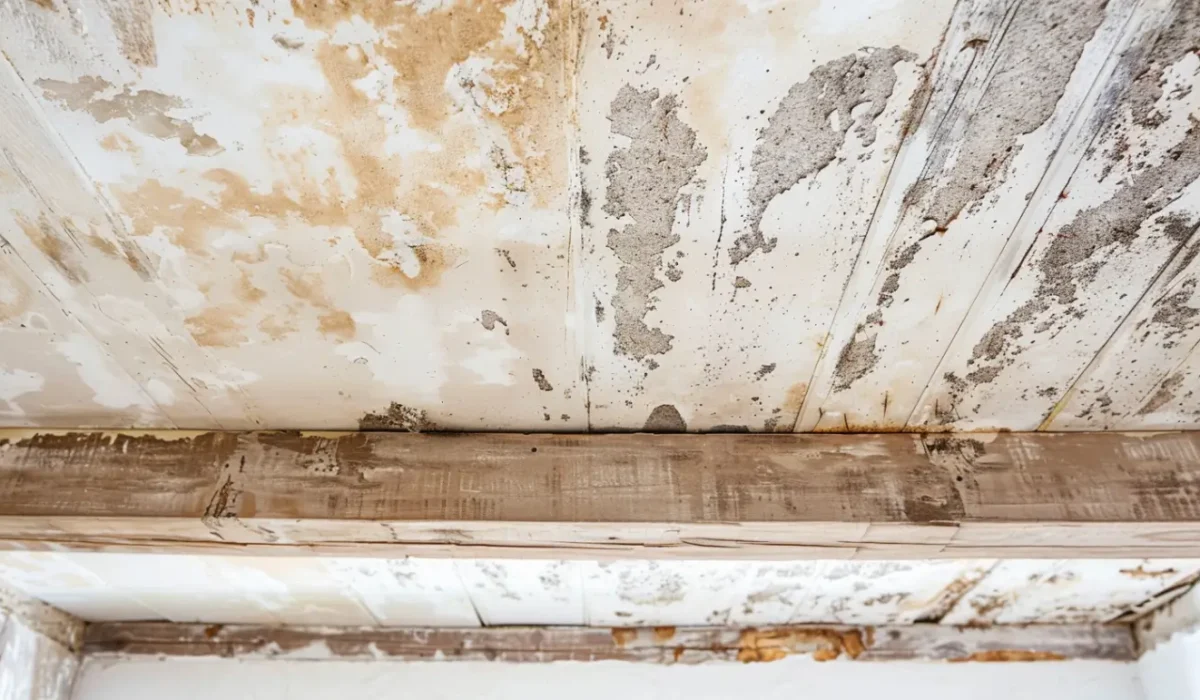You glance up at your ceiling and notice a faint white or discolored patch forming above you. While it might seem harmless at first, white ceiling stains are often the earliest—and most overlooked—warning signs of a roof leak. For homeowners in Keller, TX, where storm damage, humidity, and harsh sun are regular occurrences, these stains shouldn’t be ignored.
If you’re seeing odd marks or spots appearing on your ceilings, here’s what they could mean—and why now is the time to take action.
What Causes White or Discolored Ceiling Stains?
Ceiling stains, especially those that appear white, brown, or yellowish, are usually the result of water seeping through your roof, attic, or insulation layers. As the water dries, it leaves behind mineral deposits, often in circular or irregular patterns. Over time, the affected area may change color, swell, or develop mold.
In Keller’s variable weather—where hot, dry days can suddenly give way to wind-driven rain or hail—the rapid expansion and contraction of roofing materials can lead to gaps or cracks that allow moisture in. These entry points may go unnoticed for weeks until they begin revealing themselves through interior damage.
Where to Look for Signs of Roof Leaks
White ceiling stains are often the first visible indicator of a larger roofing issue. Be on the lookout for:
- Stains near corners or along the tops of walls
- Circular or irregular shapes forming in the center of a room
- Streaking patterns that suggest ongoing leaks or hidden pipe issues
- Peeling paint or bubbling drywall
If you notice these signs, especially after a storm or hail event, it’s likely that your roofing system has been compromised.
What White Ceiling Stains Really Mean
Stains may vary in size and intensity, but they typically point to one of the following issues:
1. Minor Roof Damage
Small, isolated stains can mean that a few shingles or flashing sections have been damaged—often by wind or flying debris. Even a pinhole in your roofing underlayment can allow enough moisture through to cause staining over time.
2. Attic Condensation
In winter or after significant temperature swings, poor attic ventilation can lead to condensation. This moisture builds up inside the roof cavity and eventually soaks into the ceiling.
3. Long-Term Moisture Exposure
Larger white stains with spreading edges often suggest an ongoing issue—like improperly sealed roof penetrations (vents, skylights, chimneys) or deteriorated underlayment.
4. Ice Dams (During Sudden Cold Snaps)
Though rare in Keller, TX, occasional winter storms can cause ice dams, particularly on older or poorly insulated roofs. Water backs up under shingles and leaks into the home when it begins to melt.
Why You Shouldn’t Wait to Address It
A white ceiling stain might seem like a small cosmetic flaw, but behind the surface, it’s usually a sign of moisture infiltration—something that can lead to:
- Mold and mildew growth
- Insulation damage
- Electrical hazards
- Rotted roof decking or framing
The longer the problem is left unresolved, the more costly the repairs become—not only to your roof but also to your home’s interior structure and air quality.
What to Do If You Spot a Ceiling Stain
1. Document the Damage
Take clear photos and note when you first noticed the stain. Monitor whether it grows or changes color after storms or rainfall.
2. Schedule a Roof Inspection
A professional roofer can assess the roof above the stain, inspect attic insulation and ventilation, and pinpoint the source of the leak. In Keller, TX, homeowners trust KangaRoof for reliable, honest evaluations and expert repairs. KangaRoof offers prompt response and storm-tested solutions that address both visible and hidden damage.
3. Repair the Leak Immediately
Whether it’s a missing shingle, damaged flashing, or worn sealant, the key is to fix the problem before more water enters. Delaying repairs can lead to deeper structural problems and invalidate your roofing warranty.
4. Restore the Interior Safely
Once the leak is repaired, you can safely address ceiling restoration. This may include replacing water-damaged drywall, repainting, and inspecting for mold growth in insulation or attic cavities.
Prevention Tips to Avoid Future Stains
- Schedule annual roof inspections, especially after hail or high winds
- Clean gutters regularly to prevent water backup under the eaves
- Trim nearby trees to reduce debris and falling branches
- Ensure attic ventilation is adequate to prevent condensation buildup
- Monitor ceilings and attics after major storms for new signs of water damage
Final Thoughts: A Stain Is a Signal—Don’t Ignore It
White ceiling stains aren’t just a minor annoyance—they’re often your roof’s first cry for help. Especially in Keller’s storm-prone climate, these marks usually mean water has already breached your roof and is beginning to compromise your home’s interior.
Act quickly. Call a professional, stop the damage in its tracks, and restore peace of mind before the next storm hits.
Read also our blog: Fall & Winter Roof Inspection Guide for Homeowners
